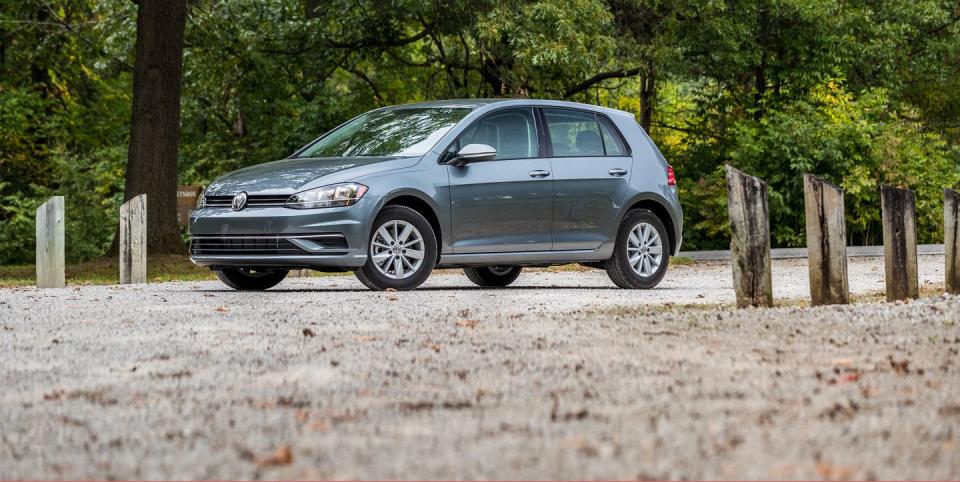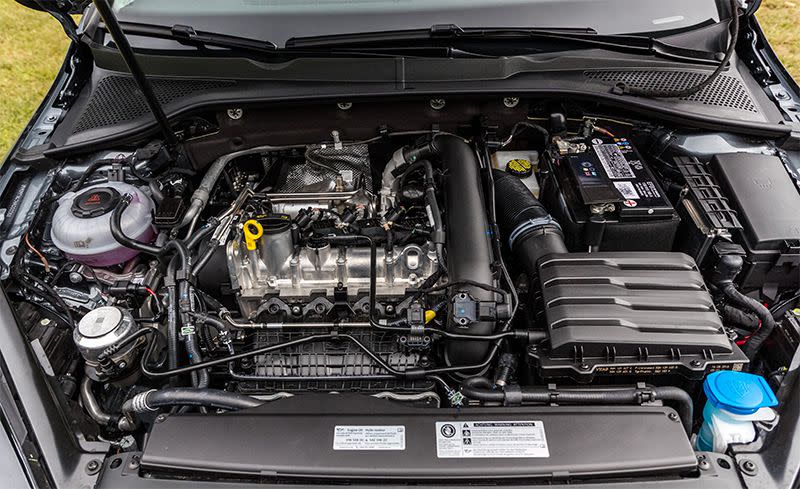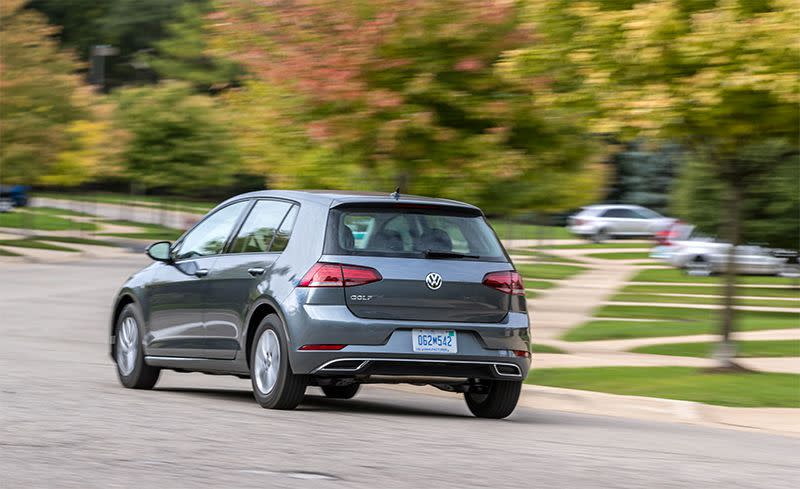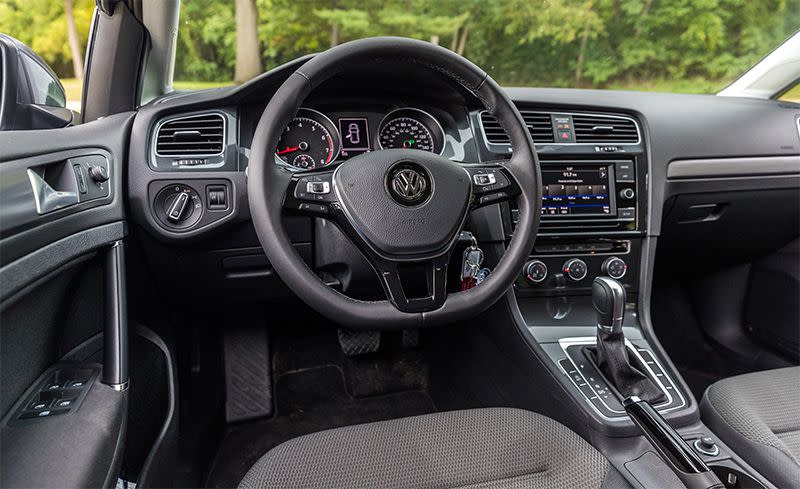The 2019 Volkswagen Golf's Excellence Is Undiminished by a Smaller Engine

Engines are shrinking. From econocars to supercars, from pint-size roadsters to full-size pickups, engine downsizing is happening across the industry. One of the latest to succumb to the trend is one of our favorites: the 10Best Cars stalwart Volkswagen Golf, which for 2019 drops its 170-hp turbocharged 1.8-liter inline-four base engine in favor of a turbo 1.4-liter four that's not only smaller but less powerful at just 147 horses. Its 184 lb-ft of torque remains unchanged for the manual-transmission models but is down by 15 lb-ft from the previous automatic's 199.
But wait! This is not a sad story. While those output losses are not negligible, they have been largely offset by new transmissions with additional gears. A standard six-speed manual-finally!-or optional eight-speed automatic has replaced the 2018 Golf's five-speed stick and six-speed autobox. Furthermore, as is the case with the Golf's sedan counterpart, the 2019 Jetta, the aluminum-block 1.4-liter contributes not just to a marked improvement in fuel economy but a reduction in curb weight compared to the iron-block 1.8. Our base-model Golf S, equipped with no options other than the $1100 automatic transmission, weighed a scant 2918 pounds-less than any Golf we've tested since a two-door model back in 2010.
Fuel-Economy Gains
Those factors helped the Golf achieve its highest fuel-economy ratings of any gasoline-powered Golf yet, with an EPA-estimated 32 mpg combined for the 2019 models (automatic or manual) compared to 28 mpg for the automatic-equipped 2018 Golf and 29 mpg for the 2018 manual. We got very close to that combined number over nearly 900 miles of driving, averaging 31 mpg overall. And on our 75-mph highway test loop, we saw 43 mpg, beating the EPA highway estimate by a huge 6 mpg.
Even better, despite the loss of power and torque, acceleration from a stop keeps pace with the last automatic-equipped Golf we tested, a 2018 Golf SE. The 2019 car reached 60 mph in 7.6 seconds (versus 7.7 for the 2018 model) and matched its predecessor in the quarter-mile at 15.9 seconds, its 88-mph trap speed lower by 1 mph. During passing exercises, the smaller engine's relative weakness is more apparent, as it needs 4.3 seconds to go from 30 to 50 mph, 0.6 second longer than before, and 5.4 seconds to hustle from 50 to 70 mph, a 0.2-second increase. That said, while there's not much power, neither is there much lag in its delivery. Overall, we'd characterize the new turbo four's output as sufficient.
As with most other modestly powered cars, the 2019 Golf had us hammering the gas pedal pretty often during everyday driving. But unlike most other modestly powered cars, the engine didn't thrash and scream in protest when we did so. Nor did it boom at low rpm, as we observed in Golfs with the 1.8-liter and automatic combo. Only at the very upper reaches of the rev band does it start getting loud. Generally, the 1.4T is uncannily smooth and quiet in most of its operating range-a few times we had to check the tachometer at stoplights to see if it was running.
Still a Great Chassis
Our test car was a base Golf S model and rode on 195/65R-15 Bridgestone Ecopia EPA422 Plus tires, which could partially account for its 177-foot stop from 70 mph. That's eight feet longer than the 2018 Golf SE required; it weighed 158 pounds more but was fitted with more aggressive 205/55R-16 Hankook Kinergy GT tires. Despite its modest rubber, the 2019 Golf clung to the asphalt with 0.84 g of lateral grip, which is a tick more than the 0.83 g we observed with the 2018 car.
That tiny improvement at the skidpad understates the impact a lighter nose has on handling. While we have long touted the Golf's steering as lively, it now feels even more eager to change direction and offers genuine tactility transmitted through the steering wheel's thin, leather-wrapped rim. It also continues to track as well at high speeds as an Audi costing twice as much.
Unpretentious Yet Upscale
Otherwise, the car remains pretty much the same unpretentious yet upscale offering it has long been-same perfect seating position, same excellent outward vision, same Costco-friendly cargo-carrying capability. A mid-cycle facelift for 2018 straightened what few curves the Golf's exterior had left and upgraded some interior bits and pieces, leaving the seventh-generation Golf as dapper and aspirational as it has ever been.
The Golf S sure doesn't feel like a stripper. Although it lacks a sunroof, heated seats, automatic climate control, navigation, satellite radio, and certain driver aids such as lane-keeping assist and active cruise control, life with the base Golf S is far from bad. You still have to twist a key to turn it on-keyless access and push-button start arrive with the SE-but it does come with paddle shifters, cruise control, comfortable mesh fabric upholstery, and a sophisticated touchscreen infotainment system. A pleasing mix of surfaces and textures show that much thought was put into this car's interior design, with contrast stitching spiffing the place up a bit.
There is some bad news to report, which is that prices have climbed by nearly a grand for 2019, severely lengthening the payback period for any fuel-related savings. That said, the standard equipment list has grown to include forward-collision warning and automated emergency braking, as well as blind-spot monitoring and rear cross-traffic alert. The 2019 Golf represents net improvement in a car that has been a regular on our 10Best Cars list. At the very least, this car is good enough to make the subject of engine downsizing much less troubling.
('You Might Also Like',)

 Yahoo Autos
Yahoo Autos 


